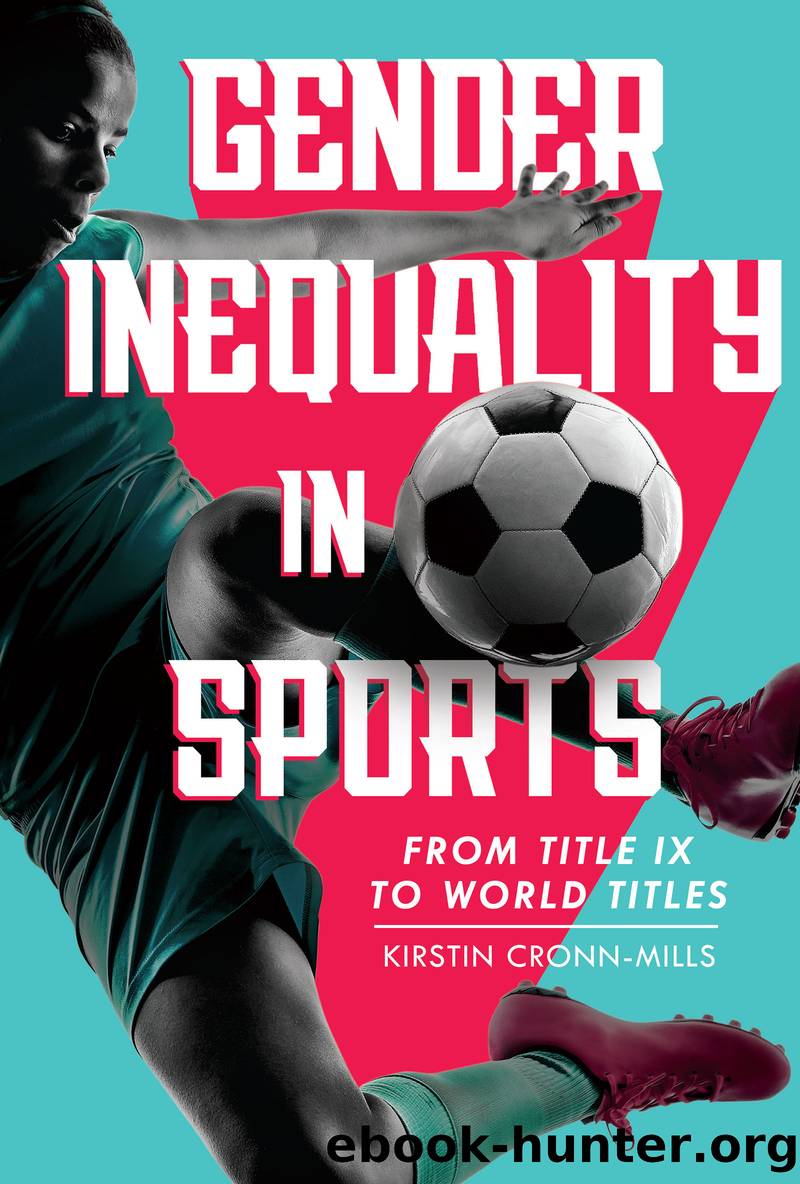Gender Inequality in Sports: From Title IX to World Titles by Kirstin Cronn-Mills

Author:Kirstin Cronn-Mills [Cronn-Mills, Kirstin]
Language: eng
Format: epub
Tags: Nonfiction, Young Adult Nonfiction, Young Adults, trans athletes, gender inequality in athletics, equality versus equity, feminism, prejudice in sports, intersectionality, title ix, equal pay for female athletes, sexism in sports, anti-transgender laws, transgender athletic policies, discrimination in athletics, women's professional sports, sexism, misogyny, female athletes, women athletes, sexual harassment, gender expression, gender identity, nonbinary athletes, women coaches, testosterone levels
ISBN: 9781728455938
Publisher: Lerner Publishing Group
Published: 2022-01-02T00:00:00+00:00
Gera (left) calls a player safe during a Catholic Youth Organization baseball game in 1968.
Equal Exposure
A significant way we could move toward equality in womenâs sports would be to promote womenâs sports in our mediaâwhether the medium is television, radio, newspapers, magazines, or social media. Most people donât know women have major sports leagues or organizations in football, basketball, soccer, softball, hockey, roller derby, tennis, bowling, and golfâmost people also donât know women are paid to play their sports in football, softball, ice hockey, basketball, and soccer. Why? Fifty years after the passage of Title IX, itâs still rare to see these games and matches on broadcast or cable television channels.
In fact, TV coverage of womenâs sports has declined. Researchers say that the decline could be because some womenâs sports were relegated to the âtickerâ at the bottom of ESPN channelsâthe ticker was considered enough inclusion for womenâs sports, even though they were literally at the margins of the screen. Researchers also speculated that the decline of coverage has been tied to societal calls for treating women as humans rather than objects. If women athletes couldnât be a punch line or a sexy photo, networks may have decided they werenât worth covering.
A common complaint for sports fans is âwomenâs sports are boring.â Is that complaint popular because fans arenât exposed to womenâs sports? A small study done with college students in 2017 indicates that attitudes can be changed by exposure. After three weeks of exposure, the study found prejudices about women athletes had changed, though participant attitudes didnât change about womenâs sports as a whole. The only way we can judge a flexible concept like âboringâ is to compare equal elements of menâs and womenâs sports. According to Cheryl Cooky, a gender and sports researcher from Purdue, womenâs sports will always be judged more âboringâ because of how theyâre covered in the media: âMenâs sports are going to seem more exciting. . . . They have higher production values, higher-quality coverage, and higher-quality commentary. . . . When you watch womenâs sports, and there are fewer camera angles, fewer cuts to shot, fewer instant replays, yeah, itâs going to seem to be a slower game, itâs going to seem to be less exciting.â
The Tucker Center for Research on Girls & Women in Sport at the University of Minnesota produced a documentary in 2013 about media coverage and female athletes. The centerâs research has found, over more than twenty years of studying media coverage, that womenâs sports get about 4 percent of media coverage, even though women make up 40 percent of the countryâs athletes. In those same longitudinal studies, the portrayal of women athletes has appeared in three primary ways: away from their playing field, out of their sports uniform, and in suggestive or sexual poses. Those three primary ways are, of course, not representative of women actually playing sports and showcasing their athletic strengths and talents. The documentary also notes that generating interest in womenâs sports and providing media
Download
This site does not store any files on its server. We only index and link to content provided by other sites. Please contact the content providers to delete copyright contents if any and email us, we'll remove relevant links or contents immediately.
Understanding Your Parents' Divorce by Becky Lenarki(886)
This Book is Gay by Juno Dawson(588)
Welcome to Sex (Welcome To You Series) by Melissa Kang & Yumi Stynes(384)
What's the T?: The Guide to All Things Trans Andor Nonbinary by Juno Dawson(231)
Accountable by Dashka Slater(204)
Always Smile by Alice Kuipers(198)
The DBT Skills Workbook For Teens - Understand Your Emotions and Manage Anxiety, Anger, and Other Negativity To Balance Your Life For The Better by Bucket The Mentor(196)
The World Between Us by Sarah Ann Juckes(171)
No Way, They Were Gay? by Lee Wind(161)
The PTSD Survival Guide for Teens by Sheela Raja & Jaya Ashrafi(155)
Human Trafficking by Lita Sorensen(155)
Racism in America by Meghan Green(154)
The Fight for Disability Rights by Lisa A. Crayton(150)
The Gay Liberation Movement by Sean Heather K. McGraw(149)
Sex: A Book for Teens by Nikol Hasler(147)
Choosing to Live, Choosing to Die by Tate Nikki;Wuthrich Belle;(147)
Autism Playbook for Teens by Carol Moog(146)
Race Relations by Barbara Diggs(142)
Inspired to Action by Jean Rawitt(140)
